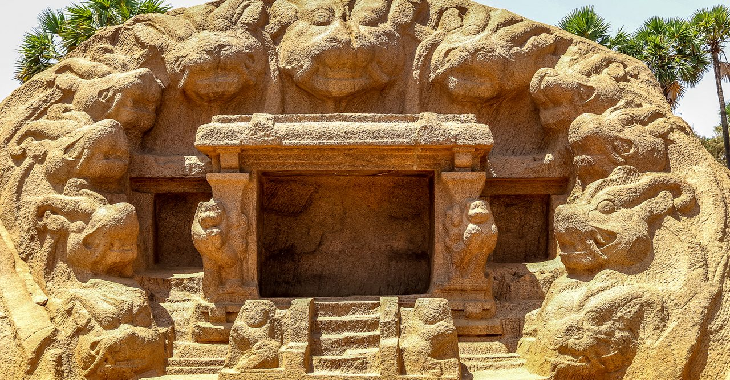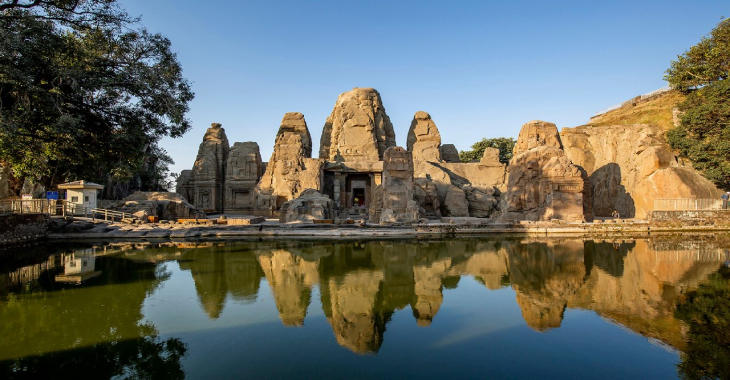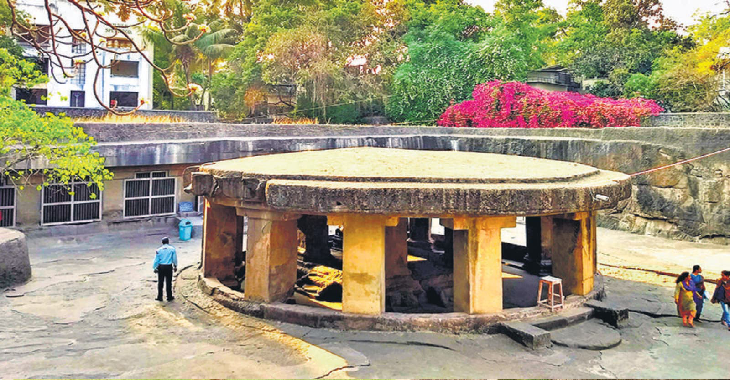India, with its rich and diverse cultural heritage, boasts some of the world’s most magnificent architectural wonders. Among these, rock-cut temples stand as a testament to the incredible craftsmanship, devotion, and innovation of ancient Indian artisans. These temples were intricately carved out of solid rock, often in hillsides or cliffs, without the use of modern tools or technology. Each temple not only reflects the religious sentiments of its era but also showcases the architectural and artistic brilliance that has inspired awe for centuries.
Here is a list of the Top 10 Famous Rock-Cut Temples in India that every history enthusiast and traveler should explore:
1. Kailasa Temple, Ellora, Maharashtra

One of the most extraordinary rock-cut temples in the world, the Kailasa Temple (Cave 16) at Ellora is dedicated to Lord Shiva. Carved in the 8th century during the Rashtrakuta dynasty, the entire temple was excavated from a single monolithic rock. What makes it remarkable is its scale — it is considered the largest monolithic rock excavation in the world. With its intricate sculptures, multi-storied structures, and towering shikhara, Kailasa Temple is a masterpiece of ancient Indian architecture.
2. Ajanta Caves, Maharashtra

Though primarily Buddhist, the Ajanta Caves include beautifully carved rock-cut temples that date back to the 2nd century BCE to 6th century CE. These 29 caves contain prayer halls (chaityas) and monasteries (viharas) adorned with detailed sculptures and mesmerizing murals. The frescoes and paintings narrate the life of Buddha and Jataka tales, making it not only a spiritual retreat but also an artistic marvel.
3. Elephanta Caves, Maharashtra

Located on Elephanta Island near Mumbai, the Elephanta Caves are a collection of Hindu rock-cut temples dedicated to Lord Shiva, dating back to the 5th–8th centuries. The centerpiece is the stunning Trimurti sculpture, a 20-foot-high depiction of the three aspects of Shiva — the Creator, the Preserver, and the Destroyer. These caves are now a UNESCO World Heritage Site and serve as a popular tourist attraction.
4. Badami Cave Temples, Karnataka

The Badami Cave Temples are a group of four magnificent rock-cut caves carved into a sandstone cliff in Karnataka. Dating from the 6th century CE, these temples showcase a blend of Hindu, Jain, and Buddhist influences. The temples are renowned for their detailed reliefs, particularly the sculptures of Lord Vishnu in various avatars, including Trivikrama and Narasimha. The fusion of architectural styles and intricate carvings make Badami a must-visit heritage site.
5. Mahabalipuram Cave Temples, Tamil Nadu

Also known as Mamallapuram, this coastal town houses a series of rock-cut temples and monuments created during the Pallava dynasty in the 7th century CE. Among them, the Varaha Cave, Krishna Mandapam, and Mahishasuramardini Cave stand out. The famous Descent of the Ganges (Arjuna’s Penance), carved on a massive rock face, is a visual storytelling marvel. Mahabalipuram is also a UNESCO World Heritage Site.
6. Udayagiri and Khandagiri Caves, Odisha

Located near Bhubaneswar, the Udayagiri and Khandagiri Caves are a collection of rock-cut chambers used by Jain monks in the 2nd century BCE during the reign of King Kharavela. These caves are significant for their historical inscriptions and artistic carvings. The Rani Gumpha (Queen’s Cave) at Udayagiri is especially famous for its intricate sculptures and two-storied structure.
7. Masroor Rock Cut Temple, Himachal Pradesh

The Masroor Temples in Himachal Pradesh are a unique cluster of 15 rock-cut monolithic temples carved in the Nagara style. Believed to date back to the 8th century CE, they are dedicated to Lord Shiva, Vishnu, and other deities. Overlooking the Dhauladhar Range, the temples offer a majestic view, and the central shrine is said to have once housed a large idol of Lord Ram. Though partially damaged due to earthquakes, the site still reflects its ancient grandeur.
8. Undavalli Caves, Andhra Pradesh

Situated near Vijayawada, the Undavalli Caves are a series of rock-cut temples dating back to the 4th–5th centuries CE, showcasing both Hindu and Jain influences. The most famous is a four-storied cave with a massive reclining idol of Lord Vishnu carved from a single block of granite. The architecture exhibits a blend of Gupta and South Indian styles and highlights the religious diversity of ancient India.
9. Pataleshwar Cave Temple, Pune, Maharashtra

Tucked away in the heart of Pune city, the Pataleshwar Cave Temple is a modest but fascinating 8th-century rock-cut temple dedicated to Lord Shiva. The temple features a circular Nandi Mandapa and intricately carved pillars. Though smaller compared to other temples on this list, it remains an important heritage site and a quiet spiritual retreat amidst the urban landscape.
10. Gavi Gangadhareshwara Temple, Karnataka

Located in Bengaluru, the Gavi Gangadhareshwara Temple is a rock-cut temple known for its unique astronomical significance. Built in the 9th century, the temple is dedicated to Lord Shiva and is constructed within a natural cave. Each year in January, the setting sun’s rays pass through a specific arc and illuminate the Shiva Linga inside the cave, demonstrating the advanced knowledge of astronomy and architecture in ancient times.
Conclusion
India’s rock-cut temples are more than religious structures; they are awe-inspiring monuments to the skill and devotion of ancient Indian artisans. These temples reflect the country’s cultural richness, diversity of faiths, and architectural evolution over centuries. Visiting these historical marvels offers a profound journey through time, art, and spirituality.
Whether you’re a traveler, historian, or spiritual seeker, these top 10 rock-cut temples in India offer an unforgettable glimpse into the grandeur of the past — carved not just in stone, but in the very heart of India’s heritage.
Read More
Top 10 Temples in India to Visit in 2025
Understanding Diabetes: Prevention, Management, and Myths


